#Shaviro
Explore tagged Tumblr posts
Photo

Steven Shaviro, The Cinematic Body
163 notes
·
View notes
Text
"Nonetheless, I find the ethico-political claim made by these works of fiction to be compelling and largely true: that the maintenance of American power across the world, and of affluence for a smaller group of Americans among whom I must include myself, is contingent upon the immiseration of a large majority of human beings, and only the complete elimination of the American imperium and the American threat can possibly alleviate this situation."
13 notes
·
View notes
Text
Maurice Blanchot (1981) suggests that the image is not a representational substitute for the object so much as it is—like a cadaver—the material trace or residue of the object's failure to vanish completely: "The apparent spirituality, the pure formal virginity of the image is fundamentally linked to the elemental strangeness of the being that is present in absence" (p. 83). The image is not a symptom of lack, but an uncanny, excessive residue of being that subsists when all should be lacking. It is not the index of something that is missing, but the insistence of something that refuses to disappear. Images are banally self-evident and self-contained, but their superficiality and obviousness is also a strange blankness, a resistance to the closure of definition, or to any imposition of meaning. Images are neither true nor false, neither real nor artificial, neither present nor absent; they are radically devoid of essence. Empty simulacra, copies for which there is no original, they tend to proliferate endlessly, repetitiously, without hope of regulation or control. The fleeting insistence of weightless images, of reflections and projections, of light and shadow, threatens to corrupt all standards, to exceed all limits, and to transgress every law.
Steven Shaviro The Cinematic Body
27 notes
·
View notes
Text
reading thee most eye-opening book about the state of capitalism and putting it down to go see the barbie movie. i contain multitudes
1 note
·
View note
Text
Catch me at the glitch orgy like

If you're planning an orgy, don't invite too many people or the attendees will swap out to their low-poly models and it'll get all laggy
18 notes
·
View notes
Text

In this book are collected reviews, critical essays, and in-depth analyses of Dhalgren as a novel, and as commentary on life and the world. There are also discussions of how to read the novel, and clues to unraveling some of the mysteries hidden therein. Contributors include Douglas Barbour, Mary Kay Bray, Rudi Dornemann, Harlan Ellison, Robert Elliot Fox, Jean Marc Gawron, Kenneth R. James, Gerald Jonas, John Nizalowski, Steven Paley, Darrell Schweitzer, Steven Shaviro, K. Leslie Steiner, Theodore Sturgeon, and, of course, Samuel R. Delany himself.
26 notes
·
View notes
Text

Derek Mears as Judge Holden
“Judge Holden's Weltanschauung-
His Theoretical Teaching
Since the hopes of a harmony and a Kantian "perpetual peace" prove to be untenable, all that remains is war, the "ultimate practitioner," who destroys by pushing things into their eternal existence. Like Heraclitus, the judge gives war its supremacy because war shows how things really are. It contains the principle of reality and points to the fact that existence, not the mind, has to come first. In a duel, it is only the outcome that counts. It does not matter which of the participants is right or wrong. War supersedes and overwrites such distinctions. Any other preconceived framework formed by the mind will fail the test of reality. In a Nietzschean manner, the judge gives the example of the moral law as an invention for the "weak." For Nietzsche, the weak are those who cannot come to a clear-cut decision and thus establish an end. McCarthy's nihilism is so systematic that the outcome is not moralizable post factum. One cannot even suggest that "might can be right" because power is absolute and cannot be represented in terms of right and wrong; it just is. The only possible law is the "historical law" or the law of necessity that is an immediate, immanent manifestation of what is.
The judge does not reject the mind, though; he is everything but a mindless killing machine. He just gives priority to the order of existence, the all-inclusive order that contains the mind itself. A thing will still exist whether one thinks of it or not. The mind cannot create existence; only existence can by being its own cause. And because the mind cannot will anything into existence, it has to be put in its right place and recognized for what it is: a mere mode of existence, like the body, among others. This means that it cannot impose the way it thinks, its own laws, its own mode of functioning, which is merely its own mode of existence, onto what exists. This happens only when the mind starts looking at itself and, like a sorcerer's apprentice, it opens a reflection that implies consciousness and that stretches into the infinite without being able to close it. The mind has to just become an instrument through which things that exist get their voice. This univocal perspectives is the substantial link between Spinoza and Nietzsche but will connect the judge and Chigurh as well.
The fact that the mind cannot rule over things doesn't impede it from knowing them though. In his reading of Blood Meridian, Steven Shaviro calls it a "radical epistemology" that "subverts all dualisms, of subject and object, inside and outside, will and representation or being and interpretation." Things are useful "breadcrumbs" for the dedicated archivist Judge Holden while Anton Chigurh calls them "instruments.” The principle of reality is thus discerned starting from bare facts. The judge is an avid collector in his notebook because they are God's "words": "He speaks in stones and trees, the bones of things. He archives material yet truthful artifacts as if to discover a road map that would help him find his way through the "maze" of existence. He is the one who singles out the "thread of order in the tapestry," thus knowing the (one) way of existence, the way things are (or become). It is in this sense only that he will be able to "dictate the terms of his own fate." This mastery is neither a creation/imposition of a new order nor an altering of an already given one. It neither shapes one's fate nor gets rid of it altogether; one is not beyond fate. Freedom emerges from finding this one path "and not some other way," this "thread of order" in the labyrinth that conquers a mystery, a darkness that generates fear so that one's decisions are taken from an active position rather than a passive one.
Like a memento mori, these facts will keep one grounded in the necessity of the "historical law," in the very "heart of darkness" that reminds one that "death and dying are the very life of darkness". In turn, they will keep the judge away from imaginative projections of the mind that generate superstition, mystery and fear. He records them like in a citation "a l'ordre du jour” in order to maintain the state of war and thus be closer to its eternity. "It makes no difference what men think of war, said the judge. War endures. As well ask men what they think of stone. War was always here. Before man was, war waited for him. The ultimate trade awaiting its ultimate practitioner. That is the way it was and will be. That way and not some other way" (BM 259).
Judge Holden loves war because it brings about "a new and broader view" (BM 261). War is the supreme game of life that teaches the unity of existence. "War is the ultimate game because war is at last a forcing of the unity of existence. War is god" (BM 261). Playing games is "nobler" than any other action, and war is the supreme game because the wager is one's most precious possession: one's life. When one wages one's life, one wages oneself, one's identity that resides in the subject, the game will "swallow" both the player and the game itself, merging both subject and object in its unity. From the perspective of this unity of existence, one can access something more than one's life. It allows one to partake in a realm of eternity that goes beyond duration, beyond beginning and ceasing to be. At this point, even "notions of chance and fate are the preoccupations of men engaged in rash undertakings" (BM 159). The unity of existence is an all-inclusive whole that cannot be broken into contradictory parts. Its parts will be distinguished merely as forms that are still embedded in the whole. In this game of war, one cannot clearly distinguish and oppose necessity and randomness anymore. Better said, loving one's fate will affirm necessity and freedom at the same time. Further, life and death are not mutually exclusive anymore but rather inextricably connected as two halves of the same coin. Embracing one will by default affirm the other.”
- Adrian Mioc, ‘Holden and Chigurh, Cormac McCarthy and the Ethics of Power’
42 notes
·
View notes
Text
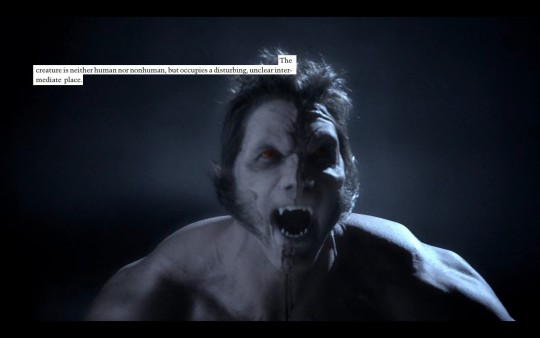
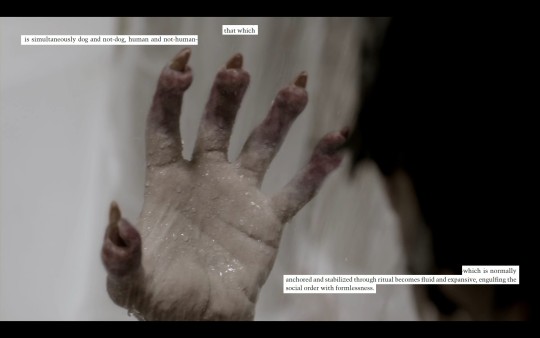
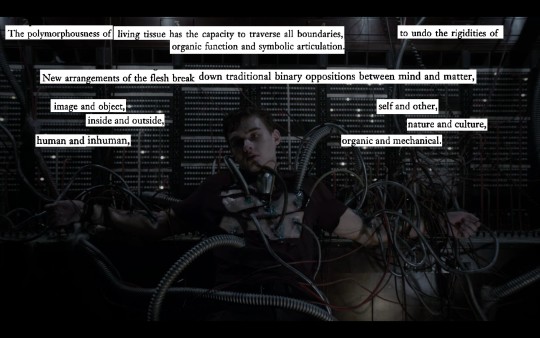
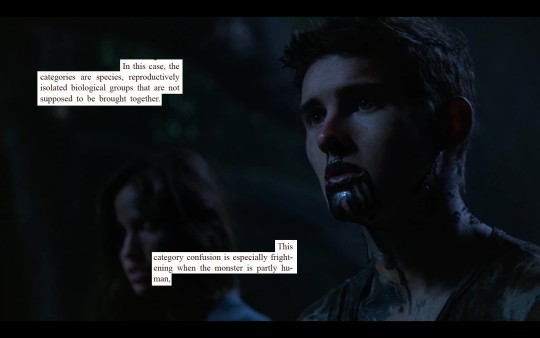

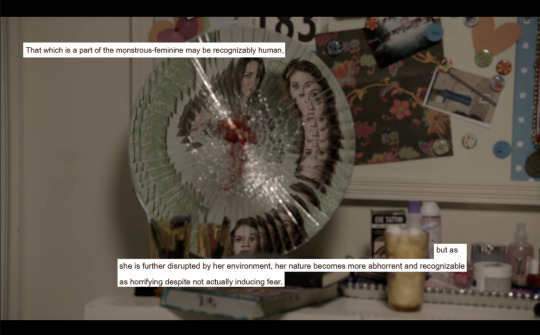
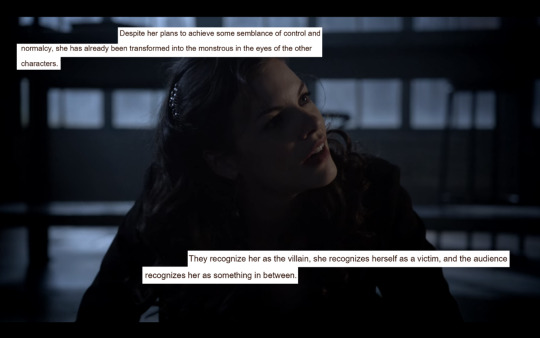
The Horror Genre in Teen Wolf
Dread, Taboo, and The Thing: Toward a Social Theory of the Horror Film by Stephen Price / Bodies of Fear: David Cronenberg by Steven Shaviro / Mutations and Metamorphoses: Body Horror is Biological Horror by Ronald Allan Lopez Cruz / Exploring Mutilation: Women, Affect, and the Body Horror Genre by Carina Stopenski
#teen wolf#teen wolf meta#the horror genre#body horror#werewolves#scott mcall#corey bryant#tracy stewart#lydia martin#jennifer blake#ethan and aiden#i am first and foremost a teen wolf scholar these days#i am the the only person who truly understand the field of teen wolf academic studies so i must make posts for y'all#mine#teen wolf academia
65 notes
·
View notes
Text
p40 (two lessons from Burroughs, steven shaviro), posthuman bodies edited by Jack Halberstam & Ira Livingston
Light sears my eyeballs, leaves its traces violently incised on my retinas. Duration imposes its ungraspable rhythms, emptying me of my own thought. Viruses and parasitic worms are at work everywhere, multiple "outsides" colonizing our “insides.” There is no refuge of pure interiority, not even before language. Whoever we are, and wherever and however we search, “we are all tainted with viral origins.”
30 notes
·
View notes
Text
Actually, while we're shaming people for their 452 unread books, here's a list of unread books of mine of which I own physical copies, attached to the year I obtained them, so that you can all shame me into reading more:
2024: Ways of Being: Animals, Plants, Machines: The Search for a Planetary Intelligence (James Bridle; just started)
2021: Islands of Abandonment: Life in the Post-Human Landscape (Cal Flyn)
2024: Extreme Fabulations: Science Fictions of Life (Steven Shaviro)
2021: The Unreal & The Real Vol. 1: Where on Earth (Ursula K. Le Guin)
2023: A Study in Scarlet (Arthur Conan Doyle)
2023: Ritual: How Seemingly Senseless Acts Make Life Worth Living (Dmitri Xygalatas)
2023: Vibrant Matter: A political ecology of things (Jane Bennett)
2023: The History of Magic: From Alchemy to Witchcraft, from the Ice Age to the Present (Chris Gosden)
2018: Ways of Seeing (John Berger)
2022: An Immense World: How Animal Senses Reveal the Hidden Realms Around Us (Ed Yong)
2020: Owls of the Eastern Ice: The Quest to Find and Save the World's Largest Owl (Jonathan C. Slaught)
2023: My Life in Sea Creatures (Sabrina Imbler)
2020: The Bird Way: A New Look at How Birds Talk, Work, Play, Parent, and Think (Jennifer Ackerman)
2023: Birds and Us: A 12,000-Year History, from Cave Art to Conservation (Tim Birkhead)
2020: Rebirding: Restoring Britain's Wildlife (Benedict Macdonald)
2022: The Song of the Cell: An Exploration of Medicine and the New Human (Siddhartha Mukherjee)
2022: An Anthropologist on Mars (Oliver Sacks)
2021: Sex, Botany & Empire: The Story of Carl Linnaeus and Joseph Banks (Patricia Fara)
2023: At The Mountains of Madness (H.P. Lovecraft)
2019: Invisible Cities (Italo Calvino; I have been trying to finish this forever and am so, so close)
2023: Brian Boru and the Battle of Clontarf (Sean Duffy)
2021: What is History, Now? How the past and present speak to each other (Helen Carr and Suzannah Lipscomb; essay collection, half-read)
2020: Winter King: The Dawn of Tudor England (Thomas Penn)
2022: Caliban and the Witch: Women, the Body, and Primitive Accumulation (Silvia Federici)
2020: Black Spartacus: The Epic Life of Touissant Louverture (Sudhir Hazareesingh; half-read)
2019: The Five: The Untold Lives of the Women Killed by Jack the Ripper (Hallie Rubenhold; 3/4 read)
2022: Lenin on the Train (Catherine Merridale)
2020: October: The Story of the Russian Revolution (China Miéville)
2019: The Villa, the Lake, the Meeting: Wannsee and the Final Solution (Mark Roseman)
2019: Heimat: A German Family Album (Nora Krug)
2018: Maus I: My Father Bleeds History (Art Spiegelman)
2020: Running in the Family (Michael Ondaatje)
2022: Wide Sargasso Sea (Jean Rhys; also never technically "finished" Jane Eyre, but I did my time, damn you)
2023: Time Shelter (Georgi Gospodinov)
2019: Our Man in Havana (Graham Greene; started, left unfinished)
2019: The Spy Who Came In From The Cold (John le Carré)
2021: Why I'm No Longer Talking to White People About Race (Reni Eddo-Lodge; half-read)
2017: Rebel Without Applause (Lemn Sissay)
2022: The Metamorphosis, and Other Stories (Franz Kafka)
2011?: The Complete Cosmicomics (Italo Calvino; vaguely remember reading these when I was maybe 7 and liking them, but I have forgotten their content)
2022: Free: Coming of Age at the End of History (Lea Ypi)
2021: Fairy and Folk Tales of Ireland (W.B. Yates)
Some of these are degree-related, some not; some harken back to bygone areas of interest and some persist yet; some were obtained willingly and some thrust upon me without fanfare. I think there are also some I've left at college, but I'm not sure I was actually intending to read any of them - I know one is an old copy of Structural Anthropology by Claude Levi-Strauss that Dad picked up for me secondhand, which I...don't intend to torment myself with. Reading about Tom Huffman's cognitive-structural theory of Great Zimbabwe almost finished me off and remains to date the only overdue essay I intend to never finish, mostly because the professor let me get away with abandoning it.
There are also library books, mostly dissertation-oriented, from which you can tell that the cognitive archaeologists who live in my walls finally fucking Got me:
The Rise of Homo sapiens: The Evolution of Modern Thinking (Thomas Wynn & Fred Coolidge)
The Material Origin of Numbers: Insights from the Archaeology of the Ancient Near East (Karenleigh A. Overmann)
Archaeological Situations: Archaeological Theory from the Inside-Out (Gavin Lucas)
And, finally, some I've actually finished recently ("recently" being "within the past year"):
The Body Fantastic (Frank Gonzalo-Crussi, solid 6/10 essay collection about a selection of body parts, just finished earlier)
An Entertainment for Angels: Electricity in the Enlightenment (Patricia Fara, also a solid 6/10, fun read but nothing special)
Babel: An Arcane History (R.F. Kuang, 8/10, didactic (sometimes necessary) but effective; magic system was cool and a clever metaphor)
The Sign of Four (A.C. Doyle, 2/10 really racist and for what)
Dr. Space Junk vs. the Universe: Archaeology and the Future (Alice Gorman, 8/10, I love you Dr. Space Junk)
In Search of Us: Adventures in Anthropology (Lucy Moore, 8/10, I respect some of these people slightly more now)
The Dispossessed (Ursula K. Le Guin, 9/10 got my ass)
The Hound of the Baskervilles (A.C. Doyle, 7/10 themez 👍)
#if you see a book on this list that you gave me years ago. well. just know that i failed.#genuinely so much worse than i thought it was but i'm making my best effort to get through them#this is honestly just for fun because i love to list things. user professionalowl bookshelf reveal. please offer reviews if you have them#hooting
8 notes
·
View notes
Text
Vampire: The Masquerade and its place in vampire movie culture
This is a short essay I wrote for a survey class of Vampire films that I'm currently enrolled in with Dr. Shaviro at Wayne State. I enjoyed doing a dive into the book and some related films.
Vampire: The Masquerade: A Critical Analysis
“Enter freely and of your own free will” is the epigraph that starts the very first page of material for the 5th edition of World of Darkness’ Vampire: The Masquerade Table Top Role-Playing Game (TTRPG), referring itself back to that most famous of vampire fictions, Bram Stoker’s Dracula novel (Hite et al 33). The game that the book describes involves a group of players creating a character from one of several “clans,” or subtypes, of vampires in an exploration of the horror of losing one’s humanity in a contemporary world of darkness, which is described as, “like our world . . . [yet] a world with secrets, deep wells of darkness – and you can stumble into them if you follow the clues” (Hite et al. 33). Narrating the action falls to one of the players who assumes the role of Storyteller, who will perform the non-player characters (NPCs) and explain the challenges and outcomes of the player’s choices. As indicated by the epigraph, the game owes its themes and even core concept to the lineage of games that came before the publishing of its first edition in 1991. Unlike other vampire media though, which delves into more abstract questions of morality and addiction, Vampire: The Masquerade puts the player in the driver’s seat of the moral challenges vampirism offers its hosts.
Though “game” is included in the genre title, TTRPG, gives the impression of something being “won” by the end of the experience. Instead, Vampire: The Masquerade would be more properly described as a collaborative storytelling experience, or even small-scale theater. This is because, much like in vampire movies themselves, there are no real winners in the end. According to game designer Mark Rein-Hagen, though he avoided Anne Rice books while designing the game, the effect that her books have had on the vampire subgenre has brought her touch to the World of Darkness setting. As we see in the despairing lines of Louis nearing the end of Interview with a Vampire (1994), the vampire’s story is always enticing yet always full of tragedy and loss. This is something that Vampire: The Masquerade excels at communicating to its players.
When turning to the page of the massive Vampire tome marked “Character creation, a particular line jumps out, as it reiterates the frequent themes that vampire fiction takes as its own, “Vampireis a game about playing a fascinating monster: an anti-hero, an addict, a parasite with a soul about to plunge into darkness or rise towards the light” (Hite 134). The subsequent basis on which the game instructs the player to build their character is on relationships with other people, be those other player-characters, vampires, humans, or other things throughout the world (Hite 134). Between the kind of “fascinating monster” that the player takes the role of as well as the characters they have connections to, we see Vampire harkening back to older vampire stories. Most obviously, so obvious its almost cliché to mention, is the correlation this has with Dracula: a character who has immense wealth and power, both politically and supernaturally, yet still relies on the humans and thralls around him to bring him from Transylvania to England. Lars Konzack notes in his article, “Mark Rein•Hagen’s Foundational Influence on 21st Century Vampiric Media,” that during an interview with Vampire’s designer, Rein-Hagen, he said that the 1980s vampire movies played a large role in shaping the game as well (119). Specifically citing The Hunger (1983) as one of the influences makes for another ripe example of the ways that other people give the vampiric figure its meaning in both the game as well as in vampire media. We see in The Hunger that the vampires Miriam and John are reliant on the humans around them both for literal sustenance but also entertainment, as in the couple’s relationship with Alice, their music tutee, and John approaching Sarah to help with his rapid aging.
It is through the vampire’s engagement with other people that it receives its meaning. This is exemplified through the Convictions and Touchstones system of morality that Vampire gives its players. For each conviction, typically an “always/never” statement of action, the vampire character has a touchstone, a non-vampire in the game world, to remind them of their conviction (Hite 146). This kind of checking in with human characters when the vampire starts losing control can be seen repeated in the film the Addiction (1995), where the main character Kathy is often found returning to speak with one of her classmates that she refuses to feed on until their very last encounter. In Martin (1977) this trope shows itself as well, with the titular character frequently calling in to the radio station to share the feelings that weigh on him as he experiences limited life in his suburban environment. Finally, in Bram Stoker’s Dracula (1992), though it comes out after the first edition of Vampire (1991), a similar relationship can be seen between Dracula and Mina that advances the plot of the entire film that’s centered around Dracula’s romantic pursuits. These struggles are all made possible, or at least more difficult, by the constant craving for blood that motivates the vampire’s actions.
Through these Touchstones, Convictions, and World of Darkness, players are able to get in the drivers’ seat of their very own vampire and feel what it would be like to live out that power fantasy, or destructive tragedy, that these creatures embody. Vampire: The Masquerade uses these familiar references to movies and popular vampire culture to make the game familiar in concept even with the variety of play and play styles that are inherent in a story told by a storyteller with their table of gaming friends.
Works Cited
Hite, Kenneth, et al. Vampire: The Masquerade. Renegade Game Studios, 2022.
Konzack, Lars. “Mark Rein•Hagen’s Foundational Influence on 21st Century Vampiric Media.” Academic Quarter, vol. 11, 2015, pp. 115–128.
Rein-Hagen, Mark. “I Am Mark Rein•Hagen, World Creator and Game Designer. AskmeAnything.” Reddit, 25 July 2014, www.reddit.com/r/IAmA/comments/2boyia/i_am_mark_reinhagen_world_creator_and_game/.
#vampire#vampire the masquerade#ttrpg#ttrpg community#film#horror#horror movies#vampire movies#class essay#grad research#grad student#graduate school#dracula
17 notes
·
View notes
Quote
Images are condemned because they are bodies without souls, or forms without bodies. They are flat and insubstantial, devoid of interiority and substance, unable to express anything beyond themselves. They are—frustratingly— static and evanescent at once, too massively present in their very impalpability. The fundamental characteristic of the cinematic image is therefore said to be one of lack.[...] Images are false, since they have been separated from the real situations of which they claim to be the representations, as well as from the material conditions in which they have been produced. They are suspect, unreliable, and 'ideological,' because they presume to subsist in this state of alienation, and even perpetuate it by giving rise to delusive 'reality effects,' rituals of disavowal, and compensatory fantasies of plenitude and possession.
Steven Shaviro, The Cinematic Body
142 notes
·
View notes
Text
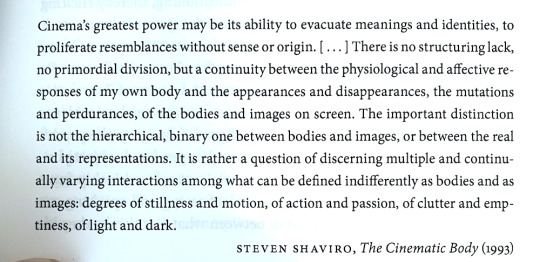
[ID: Cinema’s greatest power may be its ability to evacuate meanings and identities, to proliferate resemblances without sense or origin […] there is no structuring lack, no primordial division, but a continuity between the physiological and affective responses of my own body and the appearances and disappearances, the mutations and perdurances, of the bodies and images on screen. The important distinction is not the hierarchical, binary one between bodies and images, or between the real and its representations. It is rather a question of discerning multiple and continually varying interactions among what can be defined indifferently as bodies and as images: degrees of stillness and motion, of action and passion, of clutter and emptiness, of light and dark. — Steven Shaviro, The Cinematic Body (1993) end ID]
7 notes
·
View notes
Text
"For we suffer from reminiscences, and every reminiscence is a wound: whether slashed across the epidermis, or hacked out by the fraying of neural pathways in the brain." Steven Shaviro on Kathy Acker
5 notes
·
View notes
Text

this makes me go insane
#research for my master's thesis and i didn't expect to like this so much in both a personal and academic sense#relevant for succession watchers in obvious ways#(the text is post cinematic affect by steven shaviro)#sorry for uni posting lol#.me
0 notes
Text
If our emotions are no longer "real," it's because they are no longer strictly personal; we've passed a certain threshold, and entered this new, singular, anonymous space.
- Quoted from Steven Shaviro's essay on My Bloody Valentine
2 notes
·
View notes